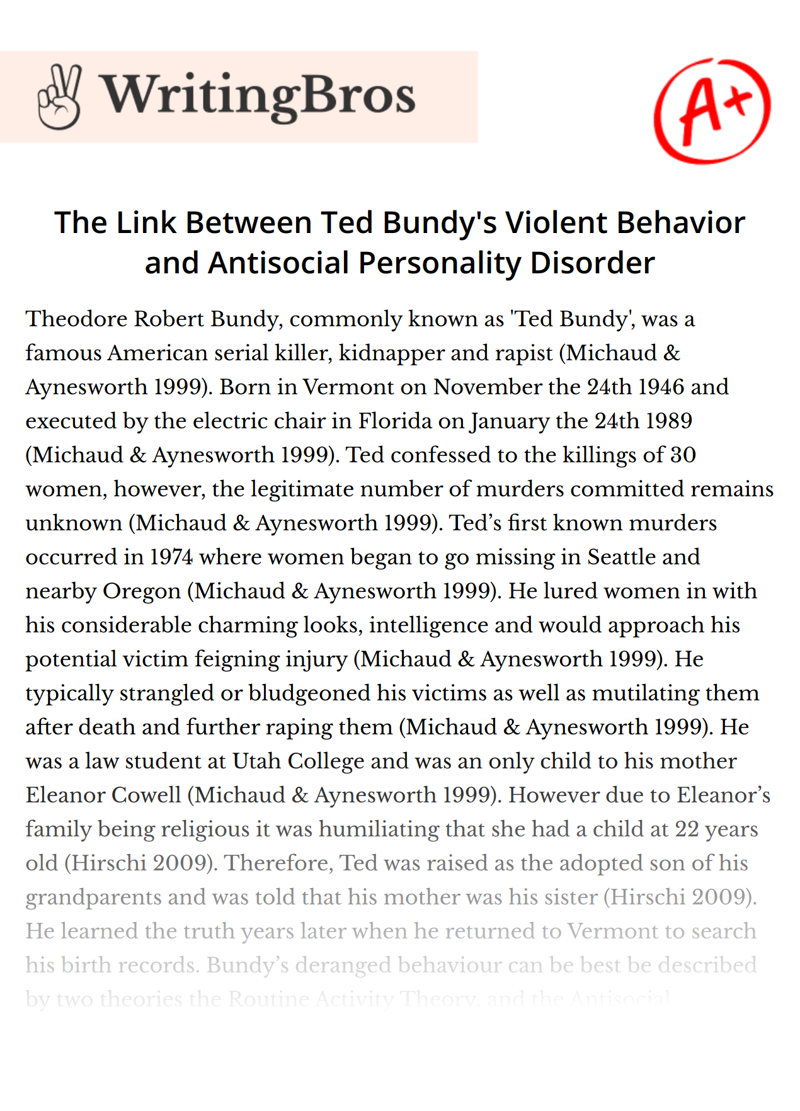The Link Between Ted Bundy's Violent Behavior and Antisocial Personality Disorder

Theodore Robert Bundy, commonly known as 'Ted Bundy', was a famous American serial killer, kidnapper and rapist (Michaud & Aynesworth 1999). Born in Vermont on November the 24th 1946 and executed by the electric chair in Florida on January the 24th 1989 (Michaud & Aynesworth 1999). Ted confessed to the killings of 30 women, however, the legitimate number of murders committed remains unknown (Michaud & Aynesworth 1999). Ted’s first known murders occurred in 1974 where women began to go missing in Seattle and nearby Oregon (Michaud & Aynesworth 1999). He lured women in with his considerable charming looks, intelligence and would approach his potential victim feigning injury (Michaud & Aynesworth 1999). He typically strangled or bludgeoned his victims as well as mutilating them after death and further raping them (Michaud & Aynesworth 1999). He was a law student at Utah College and was an only child to his mother Eleanor Cowell (Michaud & Aynesworth 1999). However due to Eleanor’s family being religious it was humiliating that she had a child at 22 years old (Hirschi 2009). Therefore, Ted was raised as the adopted son of his grandparents and was told that his mother was his sister (Hirschi 2009). He learned the truth years later when he returned to Vermont to search his birth records. Bundy’s deranged behaviour can be best be described by two theories the Routine Activity Theory, and the Antisocial Personality disorder.
The Routine activity theory developed by Cohen and Felson emphasizes that crime occurs when these three elements come together. Firstly, a motivated offender, secondly, a suitable target, and thirdly, the absence of a capable guardian (Purpura 2012). An offender may routinely walk through specific neighbour hoods looking for homes that appear as easy targets for burglary or into buildings in a commercial area to seek opportunities for crime (Purpura 2012). The routine activity theory describes how likely offenders come to commit a crime partly based on their normal everyday activities (Purpura 2012). Ted always took an opportunity to commit a kidnapping when he could, this was based on the environment he was situated in (Michaud & Aynesworth 1999). His surrounding college environment was a perfect opportunity for Ted to prey on women (Ramsland 2013). Furthermore, at the time of his study at Utah College, several female corpses appeared (Ramsland 2013). The routine activity theory significantly explains Ted’s behaviour. Firstly, Ted was a motivated offender, he admitted that on some level sexually motivated homicides were appealing (Ferguson et al. 2003). This is demonstrated through the 30 murders he committed, many who suffered physical and sexual abuse and in some cases he performed necrophilia on his victims (Michaud & Aynesworth 1999). Secondly, a suitable target, Ted prayed on typically young innocent and vulnerable women whom were students, they fell for his fake facade of an innocent injured man (Michaud & Aynesworth 1999). Therefore, he would often pray on these women when there was no public figures, friends or family members around to defend or take notice of their disappearance. In summary, as discussed it can come to a conclusion that the routine activity theory resembles Ted’s behaviour leading up to committing murder.
People with antisocial personality disorder tend to disregard authority, the law or the rights of others (Australian Government 2016). They may tell lies, behave aggressively or engage in illegal behaviour such as stealing, drug taking and violence (Australian Government 2016). People with antisocial personality disorder are said to lack remorse or a conscience, are deceitful and generally do not feel sorry for their actions (Australian Government 2016). It is said that individuals with this disorder are highly successful, intelligent and charming but exploit others for their own personal gain (Australian Government 2016). Antisocial personality disorder dramatically explains Ted’s behaviour because his personal traits match the behaviour, this is proven by psychologists that participated in a study concerned with the personality structure of Ted Bundy.
Psychologists were asked to describe Ted in terms of the American Psychiatric Association’s personality disorder nomenclature and the most commonly diagnosed personality disorder was antisocial (Samuel & Widiger 2007). It was endorsed by almost 96% of the study, in fact, nearly 80% of the psychologists described Ted as a common case of antisocial personality disorder (Samuel & Widiger 2007). Other antisocial personality traits such as disregard to authority and the rights of others corresponds to ted’s behaviour. He exhibited a lack of empathy for not only his victims, but their families. Killing numerous amount of times, it is clear that Bundy’s moral compass was non-existent ( Lilienfield & Arkoitz 2007). Lack of remorse is displayed in his behaviour when Ted showed no signs of remorse or guilt for his actions, and often seemed to take pride in how many women he had effectively fooled and killed (Labrode 2007). Deceitfulness is illustrated in Bundy’s behaviour, he would often walk on crutches or wear a fake cast and impersonate authority figures, enlisting aid of a young woman (Samuel & Widiger 2007). He was able to manipulate the legal system, escaping from Colorado prison and effectively delaying his execution for a decade(George & Dekle 2011). Bundy was described as competent, orderly, achievement orientated, charming and intelligent (Samuel & Widiger 2007). He would often use his charms as lures to trap his victims and exploit them for his own personal gain (Michaud & Aynesworth 1999).
In conclusion, Ted’s personality traits can strongly be linked to the behaviour traits of an individual with antisocial personality disorder.
Cite this Essay
To export a reference to this article please select a referencing style below

